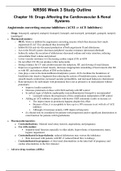Other
NR566_Week 3 Study Guide_includes Ch.16, Ch.28, Ch.36, Ch.39
- Course
- AIT Nursing (NR566)
- Institution
- Thompson River University (TRU )
Chapter 16: Drugs Affecting the Cardiovascular & Renal Systems Angiotensin converting enzyme inhibitors (ACEI or ACE Inhibitors) o Drugs: benazepril, captopril, enalapril, fosinopril, lisinopril, and moexipril, perindopril, quinapril, ramipril, trandolapril o Pharmacodynamics: o MOA: Slows or i...
[Show more]



